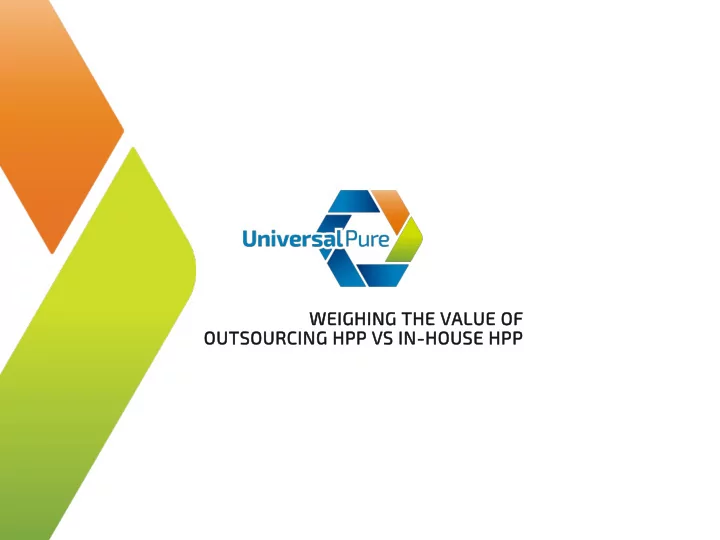

WE WEIGHIN IGHING T G THE HE V VAL ALUE OF OF OU OUTSOU OURCIN ING HP G HPP VS IN IN-HOU HOUSE HP HPP
OUTS UTSOUR URCE VS VS IN-HOU HOUSE HP HPP? What’s the best decision for your company? Does in-house HPP give us more control and flexibility? How can outsourcing HPP help avoid business challenges and complexities while saving on CapEx? Does in-house HPP help lower our costs?
KEY EY F FAC ACTOR ORS T TO O CON ONSID IDER
CAP APIT ITAL AL EXPENDIT DITURE Capex Industry Average Comments Recommended that each machine has a back- HPP Machine (525-L) $3MM - $3.5MM up, so customer commitments are not compromised Front & Back End Inkjet, scales, hopper, drying system, $400K-$500K Ancillary Equipment conveyors, tape machines, carriers, etc. Retrofit $250K-$750K* Concrete pad, water, drains, electricity Can a HIGHER RETURN on capital be ACHIEVED by investing in your CORE BUSINESS, such as R&D / Innovation, Sales and/or Marketing? 7 THIS DOCUMENT CONTAINS PROPRIETARY AND CONFIDENTIAL INFORMATION
OPER OPERATING EX EXPEN PENSES ES OpEx Industry Average Comments 7-9 line workers, 1 material Operating staff handler, 1 QA technician, Per shift 1 supervisor 1 maintenance engineer Maintenance staff Per Shift ~$100K (fully burdened) Parts ~$6.50 per cycle Not including spare parts inventory Spare parts inventory $150K Not including spare vessel ($600,000) Maintenance 8-12% Not including unscheduled downtime downtime 20-30 MM lbs. of product required to achieve full Utilization TBD utilization Utilities, CIP, ink jet, labeling, HPP audits / Other costs Site specific compliance, rent/space for equipment and product storage 7 THIS DOCUMENT CONTAINS PROPRIETARY AND CONFIDENTIAL INFORMATION
LE LEAR ARNIN ING C G CURVE During the ramp up phase, the potential for short or delayed orders are higher 6-12 months is typically required to achieve a steady state for both operations and maintenance HPP equipment is complicated and requires not just higher quality maintenance staff, it requires HPP experience as there is no comparable system in use in the food industry The results of a lack of HPP maintenance experience include: Excessive use of spare parts trying to solve problems Excessive down-time Management distraction that can be material Adds to overtime of all associated staff, not just maintenance As HPP machines age and cycles increase, the equipment has multiple levels of PM work that requires an expert to perform these PM needs. These tend to creep up on less experienced technicians and cause major delays in production.
REQ EQUIR IRED EN ENGIN GINEE EERIN ING EXP G EXPER ERTIS ISE HPP-specific engineering expertise is required to continuously tune the machine to maintain uptime, improve throughput, and keep the process operating in conformance of specifications so that customer relationships are protected Relatively simple equipment issues can result in significant downtime A highly qualified and seasoned maintenance staff is recommended to be on-site at all times The complexity of HPP operations compared to other in-plant positions creates a high turn-over rate and necessity of higher pay rates We are in discussion to help a company that owns and operates 3 HPP machines, and, In their own words, are “hemorrhaging” money due to lack of technical experience. They are spending $1MM annually on parts and have 7 technicians costing them $450K a year.
RAMP MP-UP AND ND R RAMP MP-DOWN OWN S SPEED EED AN AND FLE LEXIB XIBILIT ILITY Alternatively, demand can fall short of Companies often face product demand expectations due to many reasons such as a fluctuations shift in consumer tastes, leading to low utilization of an HPP machine Demand can surge due to successful Seasonal and promotional items can cause promotional activities or innovative new unexpected HPP backlogs. Also, SKU product launches, outstripping the capacity elimination at a retailer or food service of a single HPP machine, which in turn leads company can shut the HPP machine down to short or delayed orders entirely if this is the reason the investment was made Seasonal peaks Loss of product X approval Successful marketing campaigns Competitive offerings X Successful new product Changing consumer X launches tastes
PROD ODUCTION ION LIN LINE E E EFFIC ICIE IENCY IM IMPAC ACTS Operational efficiency of a flow process production line is reduced with the batch process HPP operation, potentially reducing production throughput and/or requiring higher inventory levels. Production delays in areas ou outsi side of the HPP process can create a subsequent demand surge which outstrips the capacity of the HPP machine and staff, leading to short or delayed orders.
COR ORE B E BUSIN INES ESS FOC OCUS Is in-house HPP a distraction today? HPP Could outsourcing HPP free up space and labor for further production initiatives? Does saving on CapEx allow for further marketing and R&D exploration? We are in discussion to help a company that owns and operates 3 HPP machines, and, In their own words, are “hemorrhaging” money due to lack of technical experience. They are spending $1MM annually on parts and have 7 technicians costing them $450K a year.
KEY EY F FAC ACTOR ORS T TO O CON ONSID IDER Do the investments and operating costs support a solid business case to perform HPP in-house? What steps will be necessary to mitigate the risks of meeting your customer commitments? Does performing HPP in-house support your core business focus?
VALU ALUE IN IN A P A PAR ARTNERSHIP HIP Let the service provider manage the burdens of volume influx, down time, and the “unknowns” Avoid the upfront and OpEx costs Maximize your core business You maintain ultimate flexibility to ramp up or down quickly, ensuring your customer needs are met while also protecting you from the cost of underutilized equipment Multiple manufacturing sites would make in-house even more complicated
Q Q & A & A S SESS SSION What other information can we share or discuss to help you make the best decision for your company?
TH THANK YO YOU! U!
Recommend
More recommend